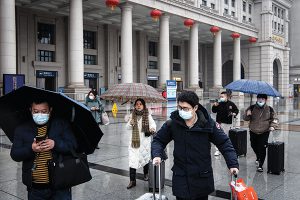It’s never safe to ignore China. And it’s still too soon to forget about the pandemic. The country’s rapidly depreciating currency and especially the Covid lockdowns spreading from city to city are raising fears, yet again, of a Chinese shock to global growth.
The weakening of the yuan over the last week cannot be ignored. Since Chinese authorities first allowed it to begin moving in 2005, it has only once before dropped as much over five days — and that was the August 2015
devaluation that sparked months of near-crisis conditions in world markets.
Why has this happened? In simple terms, China is now in a very different place in the monetary cycle from the US and Europe, and is involved in easing credit. Yields on 10-year Chinese bonds no longer offer any premium at all over Treasuries, as shown in the chart from Standard Chartered PLC below, while short-term rates are also far less generous than they were. As with other currencies, the hawkish Federal Reserve means pressure to depreciate against the dollar.
Added to the negative signal the world was sent by
the currency depreciation, there’s also the issue of Covid. China gave it to the world, but also appeared at one point to have shown the rest of us the way to deal with it, through an uncompromising “Covid-zero†policy of lockdowns and eradication. With the advent of omicron, a variant that is less dangerous but much harder to avoid catching, the logic of lockdowns looks far more questionable. It’s difficult to trust the Chinese pandemic data in toto, but the official numbers as reported to Johns Hopkins University suggests that the current wave is the worst so far.
Most importantly, Covid is now widespread. This chart from Bank of America Corp demonstrates that cases are rising in some 20 different provinces that account for three-quarters of China’s gross domestic product.
So if the government really presses on with Covid-zero — and it’s unlikely to want to admit to an error this side of the Communist Party’s congress later this year — the logic of its policy requires preparing to inflict a serious slowdown on Chinese growth.
The lockdowns have already had a grimly predictable effect on mobility. RBC Asset Management compiled this index of subway traffic in six major cities.
—Bloomberg
 The Gulf Time Newspaper One of the finest business newspapers in the UAE brought to you by our professional writers and editors.
The Gulf Time Newspaper One of the finest business newspapers in the UAE brought to you by our professional writers and editors.
